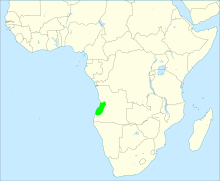| Swierstra's spurfowl | |
|---|---|

| |
| Swierstra's spurfowl in Angola | |
| Scientific classification | |
| Domain: | Eukaryota |
| Kingdom: | Animalia |
| Phylum: | Chordata |
| Class: | Aves |
| Order: | Galliformes |
| Family: | Phasianidae |
| Genus: | Pternistis |
| Species: | P. swierstrai
|
| Binomial name | |
| Pternistis swierstrai (Roberts, 1929)
| |

| |
geographic distribution
| |
| Synonyms | |
|
Francolinus swierstrai | |
Swierstra's spurfowl (Pternistis swierstrai) is a species of bird in the family Phasianidae. It is found only in Angola in the rapidly shrinking Afromontane forests of peaks such as Mount Moco and Mount Soque.[2]
Its natural habitat is subtropical or tropical moist montane forests. It is threatened by habitat loss.
The scientific name commemorates the South African entomologist Cornelis Jacobus Swierstra.
Taxonomy
Swierstra's spurfowl was described in 1929 by the South African zoologist Austin Roberts from a specimen that had been collected in Mombola, Angola. He coined the binomial name Chaetopus swierstrai, choosing the specific epithet to honour the South African entomologist Cornelis Jacobus Swierstra.[3] The species is now placed in the genus Pternistis that was introduced by the German naturalist Johann Georg Wagler in 1832.[4][5] Swierstra's spurfowl is monotypic: no subspecies are recognised.[5]
References
- ^ BirdLife International (2016). "Pternistis swierstrai". IUCN Red List of Threatened Species. 2016: e.T22678896A92793729. doi:10.2305/IUCN.UK.2016-3.RLTS.T22678896A92793729.en. Retrieved 17 November 2021.
- ^ Hirschfeld, Erik; Swash, Andy; Still, Robert (2013). The World's Rarest Birds. Princeton University Press. p. 77. ISBN 9781400844906.
- ^ Roberts, Austin (1929). "New forms of African birds". Annals of the Transvaal Museum. 13: 71–81 [72].
- ^ Wagler, Johann Georg (1832). "Neue Sippen und Gattungen der Säugthiere und Vögel". Isis von Oken (in German and Latin). cols 1218–1235 [1229].
- ^ a b Gill, Frank; Donsker, David; Rasmussen, Pamela, eds. (2020). "Pheasants, partridges, francolins". IOC World Bird List Version 10.1. International Ornithologists' Union. Retrieved 11 February 2020.
External links

